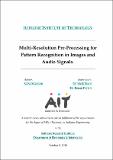| dc.contributor.advisor | Daly, Mark | |
| dc.contributor.advisor | Flynn, Ronan | |
| dc.contributor.author | Mansor, Noha | |
| dc.date.accessioned | 2022-06-30T12:38:18Z | |
| dc.date.available | 2022-06-30T12:38:18Z | |
| dc.date.copyright | 2020 | |
| dc.date.issued | 2020-10-05 | |
| dc.identifier.citation | Mansor, N. (2020). Multi-resolution pre-processing for pattern recognition in images and audio signals. Thesis (Masters - Msc (Research) in Software Engineering. Software Research Institute. Department of Electronics & Informatics AIT. | en_US |
| dc.identifier.uri | http://research.thea.ie/handle/20.500.12065/4007 | |
| dc.description.abstract | With the rapid growth of technology and the proliferation of data in this “digital
age”, most current data (imaging and audio) applications require higher data resolution, higher data transmission rates, and better compression techniques to meet
the ever increasing demands placed on them. In the case of data compression, an
ideal system must produce good quality of data with high compression ratios while
minimising the computational overhead. In other words, bandwidth cost money,
therefore, the transmission and storage of information become costly. However, if
we can use less data, both transmission and storage become cheaper.
The Haar Wavelet Transform (HWT) has been chosen, here, to fulfil the data
compression requirement of this research. The HWT is a mathematical tool that is
ideally suited for hierarchically decomposing image information. For example, it
is the preferred method by the JPEG format to produce encoded images at higher
compression ratios. In addition, it can also be used to remove irrelevant/redundant
image data to facilitate the recording, transmission, and searching of data effectively.
HWT based image compression is computationally efficient and is symmetric in
nature (both the forward and the inverse transforms have the same complexity)
allowing for the building of fast compression and decompression routines.
The aim of this research is to determine optimum compression rates for data using Machine Learning methods; typically, Artificial Neural Network (ANN). The
MNIST dataset images and the TI46 database audio are subject to a HWT transformation and a signature of the information is constructed by removing irrelevant/redundant data by means of a cut-off function. Multiple signatures for images and audio are built for differing cut-offs are then input into a neural network.
Their performances are then compared to find the optimum HWT based compression. Which, it has made the input vectors of the network much more compact and
thus easier to establish relationships between them, leading to a rapid and effective
classification of the signal. | en_US |
| dc.format | PDF | en_US |
| dc.language.iso | eng | en_US |
| dc.publisher | Athlone Institute of Technology | en_US |
| dc.rights | Attribution-Non-Commercial-Share-Alike-4.0 International | * |
| dc.rights.uri | http://creativecommons.org/licenses/by-nc-sa/4.0/ | * |
| dc.subject | Pattern recognition | en_US |
| dc.subject | Audio signals | en_US |
| dc.subject | Image | en_US |
| dc.title | Multi-resolution pre-processing for pattern recognition in images and audio signals | en_US |
| dc.type | info:eu-repo/semantics/masterThesis | en_US |
| dc.contributor.affiliation | Athlone Institute of Technology | en_US |
| dc.rights.accessrights | info:eu-repo/semantics/openAccess | en_US |
| dc.subject.department | Faculty of Engineering & Informatics AIT | en_US |


